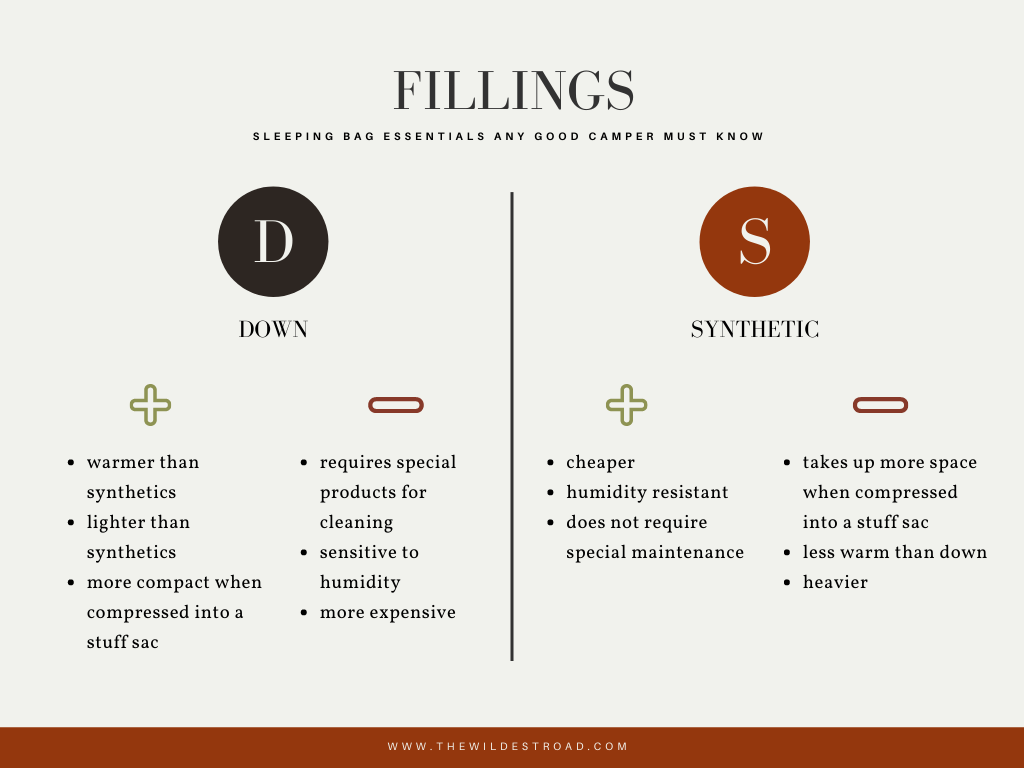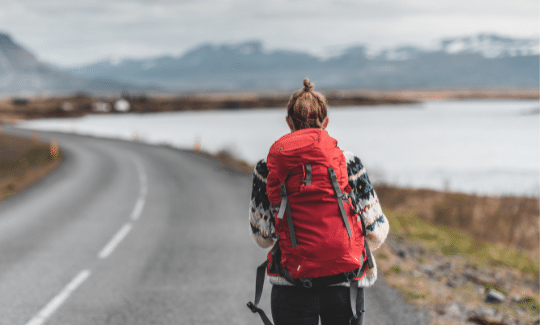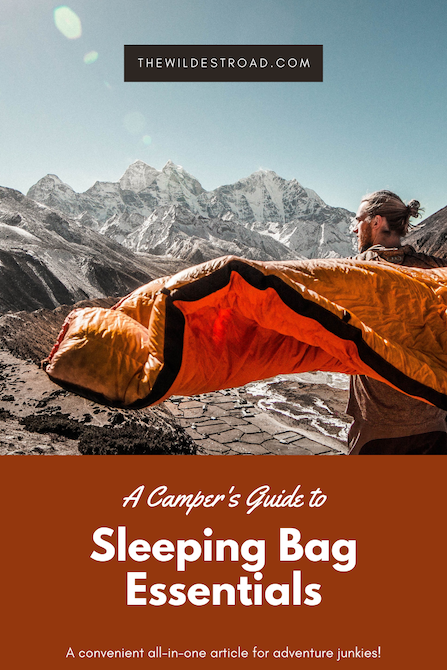Sleeping Bag Essentials Any Camper Must Know
My first camping trip was to a big summer music festival. I bought a cheap tent, got an old sleeping bag and a yoga mat and went with that. It was not particularly comfortable, but as a teenager I didn’t care. It was only for two nights and the weather was good.
Being an inexperienced camper, I decided to apply the same logic to my first wild camping trip in Norway. Despite it being the middle of summer, the temperatures still dropped close to 0°C (32°F) at night, and even though I was wearing all of my clothes and several pairs of socks, I spent every night curled up in a ball, unable to properly sleep and trying desperately to not turn into an icicle.
But how is that possible, I had a sleeping bag, surely that should have kept me warm, right?
Let’s see why I was wrong.
The sleeping bag is your blanket away from home.
It is responsible for insulating you from the surrounding air and for maintaining your body temperature.
Not all sleeping bags are the same, so let’s see what the differences are and how to choose one!
# Shapes
Sleeping bags come in two different shapes, rectangular and mummy.
Rectangular sleeping bags are wider and offer more freedom of movement, so that’s something to consider if you’re a restless sleeper or just want extra space.
On the other hand though, the wider your sleeping bag is, the more your body heat will disperse in the surrounding air.
Because of this, they are made primarily for mild to warm climates, and are almost non-existent for low temperatures.
Mummy sleeping bags are more narrow and have a hood to cover your head. The point is to have as little space inside the sleeping bag as possible in order to reduce the loss of heat.
The problem is that these models really restrict your freedom of movement, so keep that in mind if you’re claustrophobic or are a restless sleeper.
# Joining two sleeping bags
If you’re travelling with a friend or significant other, you might find it nice to know that some models can be attached together so you can use them as one!
To do that you’ll need two sleeping bags with openings on opposite sides, which will be marked on the stuff sac with either an R (right) or L (left). The models need to be of the same brand and size!
Make sure that the sleeping bag can open completely and the two sides of the zipper can detach from each other. This is necessary so that the two sides of the zipper can be joined to the corresponding ones, left to right and right to left, on the other sleeping bag.
We usually join our two Millet Baikal 750, and it’s a game changer. Just keep in mind that because of the increased space on the inside, you might have to account for some loss in the temperature rating!
This sounds a little complicated but it really isn’t, we’ll have a video coming soon to better illustrate the process!
# Fabrics
Sleeping bags are generally made of nylon, sometimes reinforced with a “rip-stop” mesh.
“Rip-stop” is a technology in which a mesh is sewn into the fabric, preventing any hole or tear from becoming larger and giving you more time to perform repairs. It is something found more commonly on higher-end models but is well worth the extra money.
If you’re planning a night under the starts, remember that sleeping bags are not waterproof!
# Temperature Rating
Many new campers make the same mistake I made all those years ago, assuming you can just use the same sleeping bag in all situations. This couldn’t be further from the truth.
You might have noticed that there are three temperatures indicated on the stuff sac of your sleeping bag. These are not decorations, they actually indicate the most important characteristic of your sleeping bag, the temperature rating.
The three numbers indicate the average temperature your sleeping bag will be ideal for. Stray too far out of this range and you’ll either find yourself sweating through the night or freezing to death.
Let’s see for example The North Face Gold Kazoo.
On the stuff sac it has indicated:
Comfort: +1°C (33.8°F)
Limit: -5°C (23°F)
Extreme: -22°C (-7.6°F)
Let’s take a look at what each of these numbers mean:
Comfort:
The best temperature on average to use the sleeping bag. Stay around this number and you’ll be fine, not too warm and not too cold.
Comfort Limit:
When in between this and the comfort rating, you might start feeling chilly. When dropping below this temperature you will gradually start feeling cold. The more you go below this value, the colder you’ll be.
Extreme:
This is extremely important, you’re not supposed to use your sleeping bag for this temperature rating! It is only meant as a safety net in case of unexpected temperature drops or cases of emergency.
At this rating you’ll feel extremely cold. Drop below though, and the sleeping bag won’t offer ANY more protection, you’ll be completely exposed. At very low temperatures this can put you at serious risk of hypothermia and death.
Always refer to the comfort range for the temperatures you expect to encounter on your trip.
Keeping the Gold Kazoo example in mind, the ratings indicate that the best temperature to use this sleeping bag is around +1°C (33.8°F). It will keep you relatively warm down to about -5°C (23°F). Below that you’ll start feeling gradually colder as you approach the extreme. At around -22°C (-7.6°F) you’re in the danger zone. Below that you’re at risk of hypothermia and death.
Do not forget that these temperatures are an average, so always choose a model that can keep you at least a few degrees warmer than the lowest temperature you expect on your trip.
# Fillings
As for the material that fills your sleeping bag, they come in two variants, synthetic and down.
Let’s see the differences:
Down Filling:
Down is a type of light feather gathered from birds. When done sustainably and without mass production it causes them absolutely no harm, so always make sure the model you’re choosing is made with humanely resourced feathers.
These sleeping bags have several characteristics that make them more suited for cold and dry weather. Because down fillings are warmer and fluffier than synthetics, there is less material needed inside the sleeping bag, making it lighter and more compact when stowed inside a stuff sac. These characteristics make them ideal for weight-conscious travellers.
There are a few disadvantages though. Because of the nature of the material, down sleeping bags are generally very expensive. They are also very sensitive to humidity. The filling absorbs the humidity in the air, both giving the inside of the bag a wet feeling and also reducing the warmth it can provide. This is why they are best used in dry environments.
Remember that snow and ice reduce the humidity in the air, so down is perfect for these weather conditions.
Keep in mind that down requires more care than synthetic materials. Down sleeping bags cannot be put in a washing machine with simple detergent, they require a special down cleaner. Personally, we prefer using the brand Nikwax, we find it gives us the best results when compared to other brands in the same price range.
The best down cleaner we can recommend is the Nikwax Down Wash Direct . It not only cleans the down, it also makes it more humidity resistant, partially negating one of the biggest disadvantages of the material.
When putting your sleeping bag to dry, make sure the bag is laid flat. Hanging and especially folding it in the middle will cause the down to accumulate on the bottom or on opposite sides, leaving gaps in the filling and reducing the effectiveness of the bag. Never put your sleeping bag in the drier, always let it dry naturally (we can unfortunately tell you from personal experience).
Synthetic Filling:
Synthetic sleeping bags are more common and cheap. Their main advantage is that, contrary to down, they absorb less humidity, making them better suited for a wider variety of environments.
They can be machine washed and do not require any special care products, even though it is better to use a technical detergent to keep your sleeping bag in top shape. Always be sure to follow the manufacturer’s instructions marked on the inside of the bag!
Synthetic fillings are not as warm compared to down, sleeping bags need more filling when made for low temperatures. This means that they will be much heavier and less compact.
# Fill Power
The fill power applies only to down and indicates the fluffiness and quality of the filling.
The higher the number, the higher the fluffiness of the down. Higher fluffiness equals more comfort and warmth. Values can range from 600 to 650 (good fill power), 700 to 750 (very good) and 800 to 950+ (top quality).
So remember, these are the important points to remember when choosing a sleeping bag:
The shape
The temperature rating
The filling
Size and weight
The fill power (only for down)
And that’s pretty much it!
Follow these steps and you’ll never spend another cold night in your tent!
See you on the trail and until next time, this is Luca, signing off.
Other articles you might enjoy:
𝘿𝙞𝙙 𝙮𝙤𝙪 𝙚𝙣𝙟𝙤𝙮 𝙩𝙝𝙞𝙨 𝙖𝙧𝙩𝙞𝙘𝙡𝙚 ?
𝘠𝘰𝘶 𝘤𝘢𝘯 𝘴𝘢𝘷𝘦 𝘰𝘳 𝘱𝘪𝘯 𝘵𝘩𝘪𝘴 𝘪𝘮𝘢𝘨𝘦 𝘴𝘰 𝘵𝘩𝘢𝘵 𝘺𝘰𝘶 𝘤𝘢𝘯 𝘢𝘭𝘸𝘢𝘺𝘴 𝘭𝘰𝘰𝘬 𝘣𝘢𝘤𝘬 𝘰𝘯 𝘵𝘩𝘦𝘴𝘦 𝘵𝘪𝘱𝘴 !









